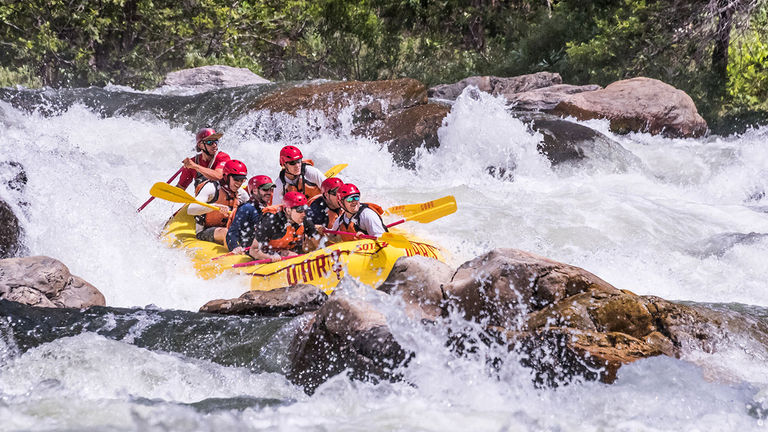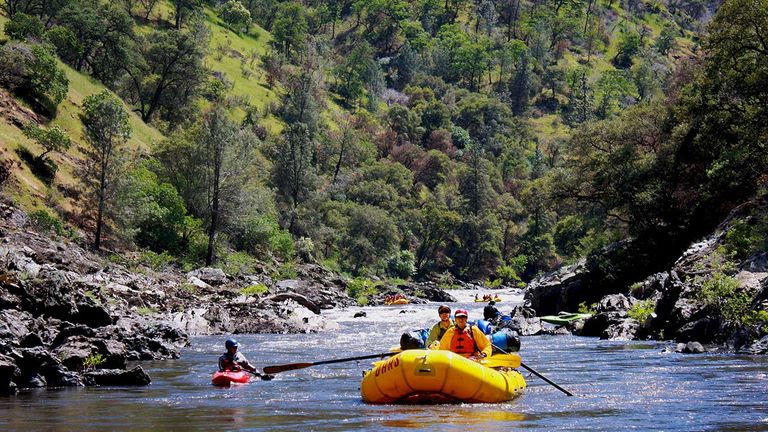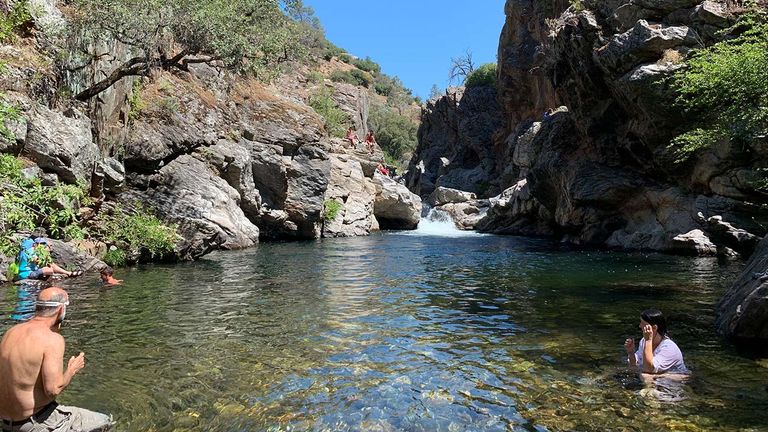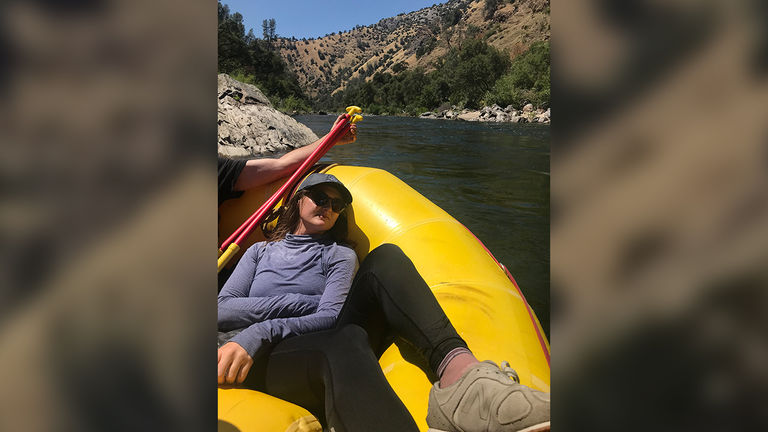I let go of the rope and swam toward the bottom of the river. In mere seconds, the swift current buoyed me up to the surface, and I gulped in a big breath of air as my head popped above the water.
Dakota, one of the crewmembers, was grinning at me widely.
“That was pretty gnarly, huh?” he said.
He pulled me onto the gear boat he was manning, and we waited for my boatmates and raft guide, Jim, to paddle out of the “hole” we had been “surfing.” Getting sucked out of the raft and into the whitewater is par for the course when on OARS’ Tuolumne River Rafting adventure near California’s Yosemite National Park.
Most of the rapids on the Tuolumne (pronounced “too-ah-lum-ee”) are Class IV. On the international scale of river difficulty, this indicates intense and powerful, yet predictable, rapids that require precise boat handling in turbulent water — aka for advanced rafters. (The scale runs from the easy Class I to the extremely dangerous Class VI.)
 With Class IV rapids, this river is ideal for advanced rafters.
With Class IV rapids, this river is ideal for advanced rafters.
Credit: 2019 James Kaiser/OARSOur surf locale of choice was just past Clavey Falls, which rates as a Class IV+ rapid and is, according to OARS, one of the most notorious rapids in the world. So, my tumble into the river was no surprise to me or any of my boatmates — and, perhaps, well-deserved, as I had requested to surf the raft. This requires hard paddling upstream against the rapid into a calm spot of water behind a rock, where careful maneuvering from all boatmembers allows the craft to float in one spot as the whitewater rushes by.
Our three-day guided rafting trip was filled with thrills like this, as well as quieter, intimate moments. When our group wasn’t navigating downstream or laughing maniacally each time we were pelted by whitewater spray, we relaxed at our riverside campsites with beers and bocce ball tournaments, or hiked to waterfalls and swimming holes. One afternoon, most of us whiled away the time half-submerged in a warm creek, where we shared life stories and talked politics, relationships and goals — conversations unexpectedly beyond surface level.
 OARS guides take care of setting up camp and preparing meals.
OARS guides take care of setting up camp and preparing meals.
Credit: 2019 Steve Markle/OARSThis was fitting with one of the delightful aspects of OARS trips: Group size is typically 12 to 16 guests, with an average guide-to-client ratio of 1:4 (trips max out at around 24 guests). Our gang of some 20 adventure-seekers hailed from around the country, and ages ran the gamut, from 17-year-old Evan — one of my boatmates who, like me, ended up an involuntary swimmer — to 60-something Jeff, who brought along homemade, barrel-aged whiskey to make mini-Manhattan cocktails for his new friends.
The OARS crew kept us well-fed, with tasty meals ranging from pita wraps and hearty sandwiches for lunches on the river, to hors d’oeuvres and pasta or steak for camp dinners — followed by treats such as brownies or chocolate-covered strawberries. A limited amount of wine and beer is available, and most guests on my trip brought their own alcohol (and gladly shared).
 Clients can also partake in activities like hiking to swimming holes, where they can jump off the rocks into the water.
Clients can also partake in activities like hiking to swimming holes, where they can jump off the rocks into the water.
Credit: 2019 Michelle JuergenBeyond the food, the fun and the fast-made friendships, however, I was most impressed with the staff. Though most crewmembers are in their 20s (and frequently use the word “dude” in their vocabulary), they were all incomparably respectful, responsible and attentive — able to seamlessly switch between having a casual chat and delivering no-nonsense safety guidelines. Keeping guests pumped up for each day’s workout on the river while also loading boats with gear, setting up and breaking down camp, preparing food and watching for hazards isn’t an easy job. But our crew made it seem like a piece of cake.
Still, clients need to be relatively fit and into roughing it for this multiday trip to be enjoyable. Paddling can be strenuous; nights are spent in basic tents; showers are taken in the river with biodegradable soap; and the bathroom is a portable toilet set in a secluded location at the campsite.
 The writer takes a break from paddling the whitewater rapids to soak in some sunshine.
The writer takes a break from paddling the whitewater rapids to soak in some sunshine.
Credit: 2019 Michelle JuergenOnce we hit the “take out” (the end of the trip where the rafts are taken out of the river), we boarded the bus that would lead us up a narrow, windy road back to the real world. By the din of our chatter, it was clear the sun and spray had barely subdued our rowdy crew. But in a rare mellow moment — perhaps we were lulled by the rhythm of the vehicle — lead trip guide Tanner seized on the quiet to reflect on our experience.
“To all of you, Tuolumne,” he said, turning to face us from the front of the bus and raising an imaginary glass. “Cheers to a grand adventure.”
The Details
OARS
www.oars.com